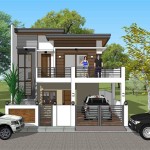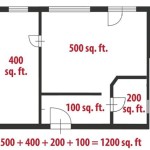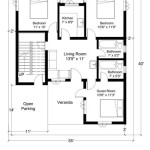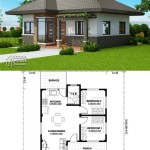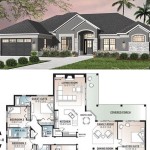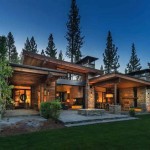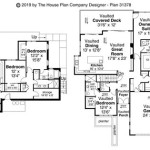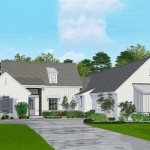Rambler House Plans: Design a Home to Suit Your Lifestyle
Rambler house plans, also known as ranch style homes, have long been a popular choice for homeowners seeking a comfortable and functional living space. Their single-story design, often characterized by a low-pitched roof and sprawling layout, offers practicality and ease of movement, making them ideal for families with young children or those who desire a more accessible lifestyle. With a rich history rooted in modern architectural trends of the mid-20th century, rambler house plans continue to evolve and adapt to contemporary needs and preferences. Whether you envision a cozy retreat for a small family or a spacious entertainer's paradise, exploring the design possibilities of rambler houses can lead to a home that perfectly reflects your unique lifestyle. This article delves into the key features, variations, and considerations that make rambler house plans a versatile and enduring choice for home builders.
The Essence of Rambler House Plans: Simplicity and Functionality
The essence of rambler house plans lies in their emphasis on simplicity and functionality. Their single-story structure eliminates the need for stairs, promoting easy accessibility and creating a sense of open flow throughout the home. This makes them particularly appealing for multi-generation households, individuals with mobility challenges, or those who prefer a less restrictive environment. The open floor plan, often a hallmark of rambler designs, maximizes the use of space, allowing for seamless transitions between various living areas. This layout also fosters a sense of spaciousness, making even modest rambler homes feel airy and inviting.
The low-pitched roof, another defining characteristic, contributes to the home's overall aesthetic and provides a clean silhouette against the sky. It also minimizes the need for complex roofing structures, contributing to the simplicity of the design. While the traditional rambler typically features a rectangular footprint, modern interpretations explore a wider range of shapes and angles, incorporating elements like vaulted ceilings, bay windows, and covered porches to enhance the visual appeal and functionality of the home.
Design Variations: Adapting to Diverse Needs
Rambler house plans offer a surprising level of versatility, allowing for customization to accommodate a wide range of needs and aesthetic preferences. The classic rambler, characterized by its symmetrical facade and straightforward layout, provides a solid foundation for those seeking a timeless and uncluttered design. However, modern interpretations of the rambler style embrace more contemporary elements, incorporating open floor plans, large windows, and modern materials like metal and glass. These adaptations enhance the home's visual appeal while providing ample natural light and a connection to the outdoors.
For those seeking a more compact living arrangement, variations like the "starter rambler" offer efficiently designed floor plans that maximize space without compromising on functionality. These smaller ramblers often feature open living areas, combined kitchen and dining spaces, and well-planned bedrooms to create a cozy and comfortable home for singles or small families. On the other hand, larger ramblers, often referred to as "contemporary ramblers," provide spacious living environments with options for multiple bedrooms, dedicated home offices, and expansive entertaining areas. These variations cater to the needs of growing families and those who desire ample space for work, leisure, and social gatherings.
Key Considerations When Choosing a Rambler House Plan
While rambler house plans offer several advantages, it's essential to consider several key factors when choosing a design that suits your lifestyle and needs:
1. Site and Topography
The size and shape of your building lot, as well as any topographical features, will play a significant role in determining the best rambler house plan for your property. A sloped lot, for example, might require a basement or a split-level design to accommodate the uneven terrain. It's crucial to consult with an architect or designer to ensure the chosen plan integrates seamlessly with the site and maximizes the available space.
2. Climate and Energy Efficiency
The climate in which you live will influence your design choices. For example, a rambler in a hot climate might benefit from a covered porch or a shaded patio to provide respite from the sun. In colder regions, proper insulation, efficient windows, and a well-designed heating system are crucial for energy efficiency and comfort. Consider consulting with an energy-efficient building expert to optimize the design for your climate.
3. Personal Lifestyle and Needs
Ultimately, the most important factor is to choose a rambler house plan that aligns with your personal lifestyle and needs. Consider the number of bedrooms and bathrooms required, the size and layout of the kitchen and living areas, and any special features that would enhance your enjoyment of the home. Whether you prioritize a spacious kitchen for home chefs, a dedicated home office for remote workers, or a large backyard for entertaining, customizing the plan to suit your lifestyle will ensure a truly fulfilling living experience.
:max_bytes(150000):strip_icc()/rx_1910_sl578-8f2e9a0630db47ee9a44bedd0c203993.jpg?strip=all)
20 Ranch House Plans That Will Never Go Out Of Style

Tips For Selecting The Right Floor Plan Your Home Sater Design Collection
:max_bytes(150000):strip_icc()/SL-2028_legacy_ranch-05be5217adc849a18d606334c333ef9f.jpeg?strip=all)
20 Ranch House Plans That Will Never Go Out Of Style

Traditional Neighborhood Designed House Plans Tnd

Traditional Neighborhood Designed House Plans Tnd

Southern Living House Plans With Photos Dfd Blog

Silverbell Ranch House Plan Farmhouse Archival Designs

Family Home Plans We Love Blog Eplans Com

Plan 80814 Ranch House With Outdoor Kitchen

Spacious And Open Best Floor Plans For Families Blog Homeplans Com
Related Posts

